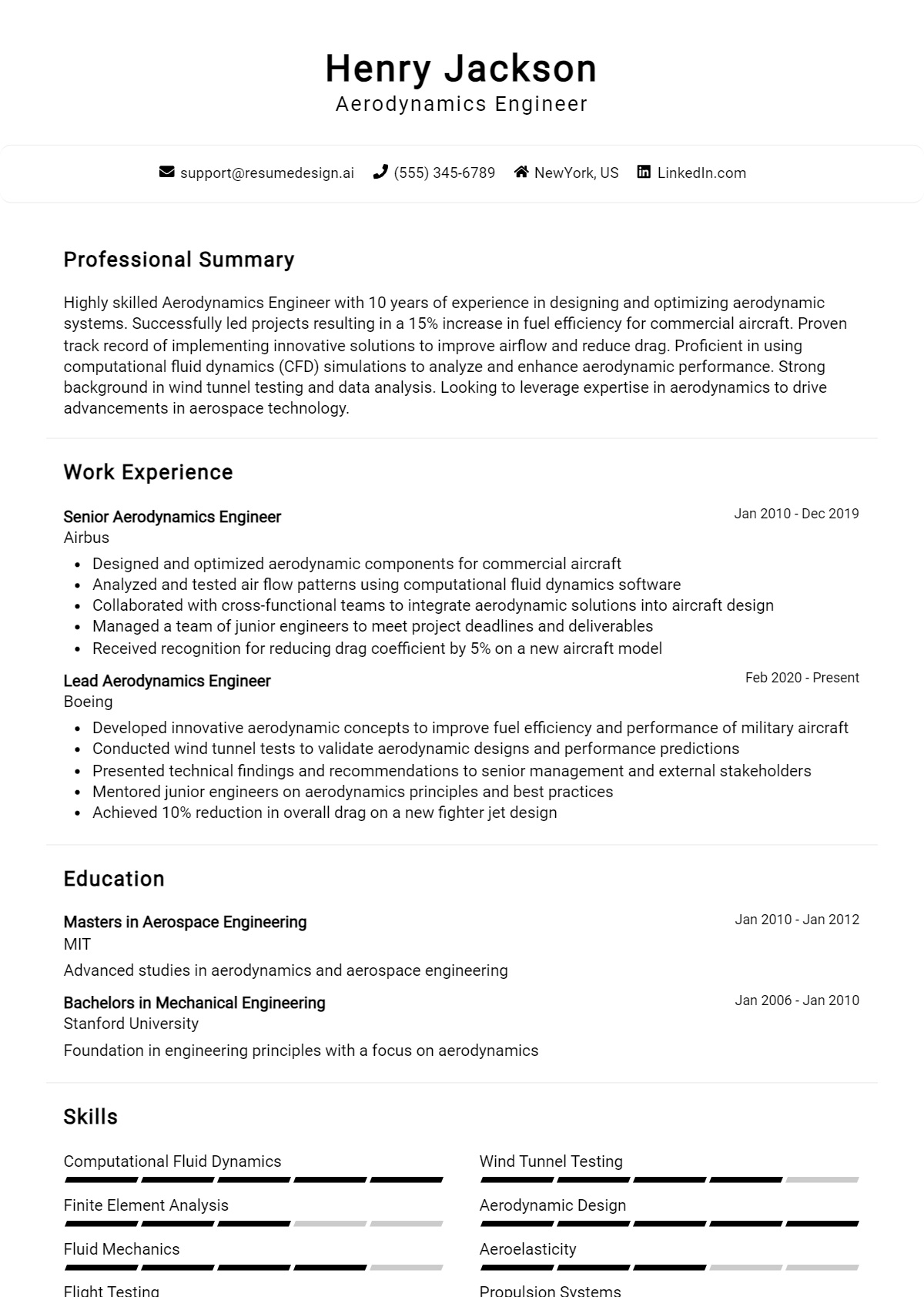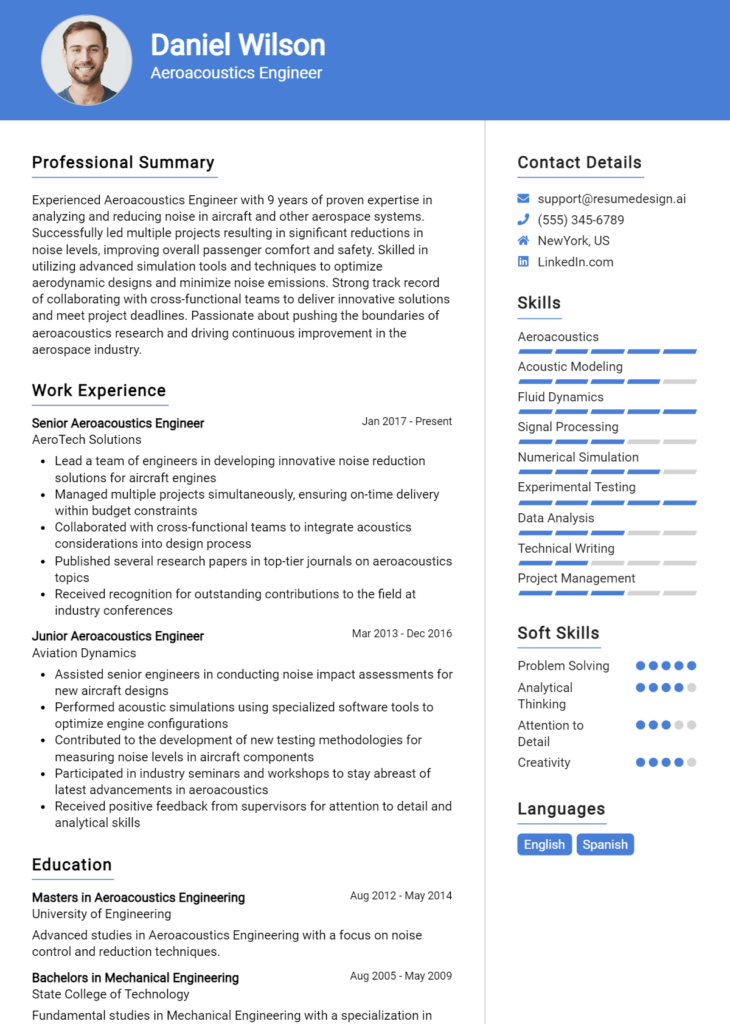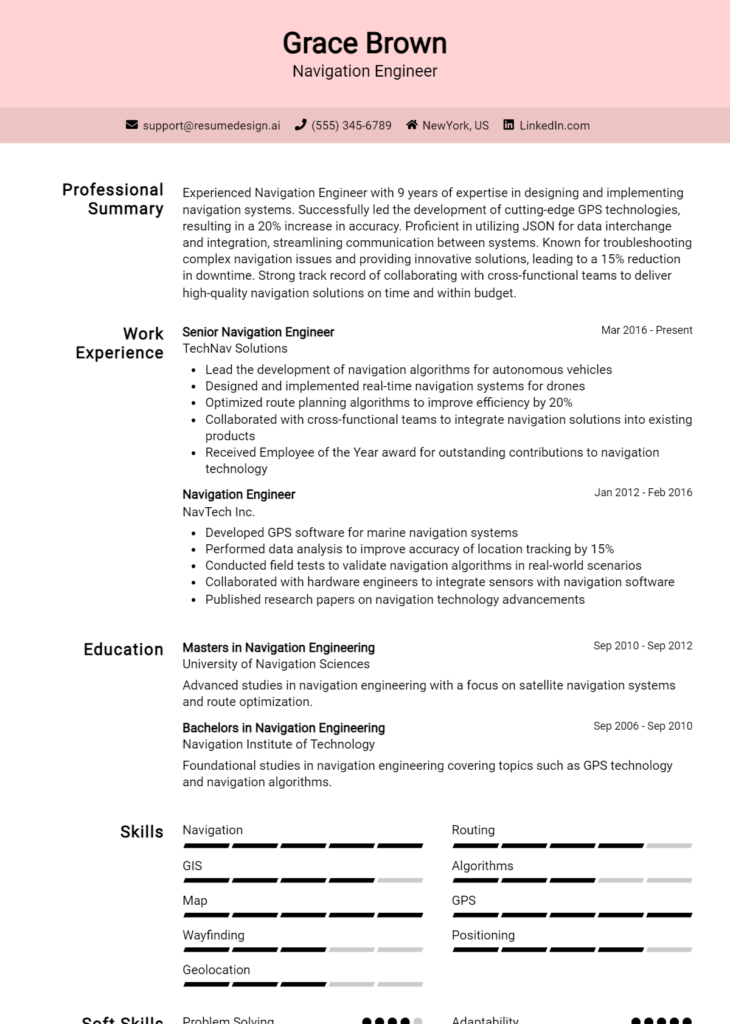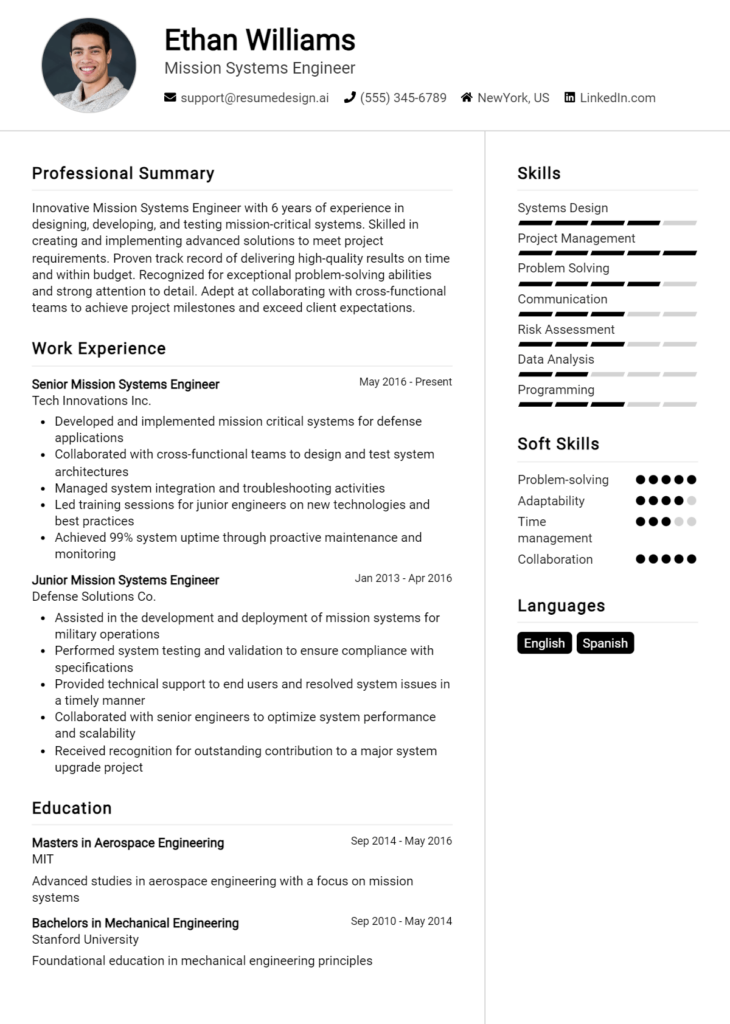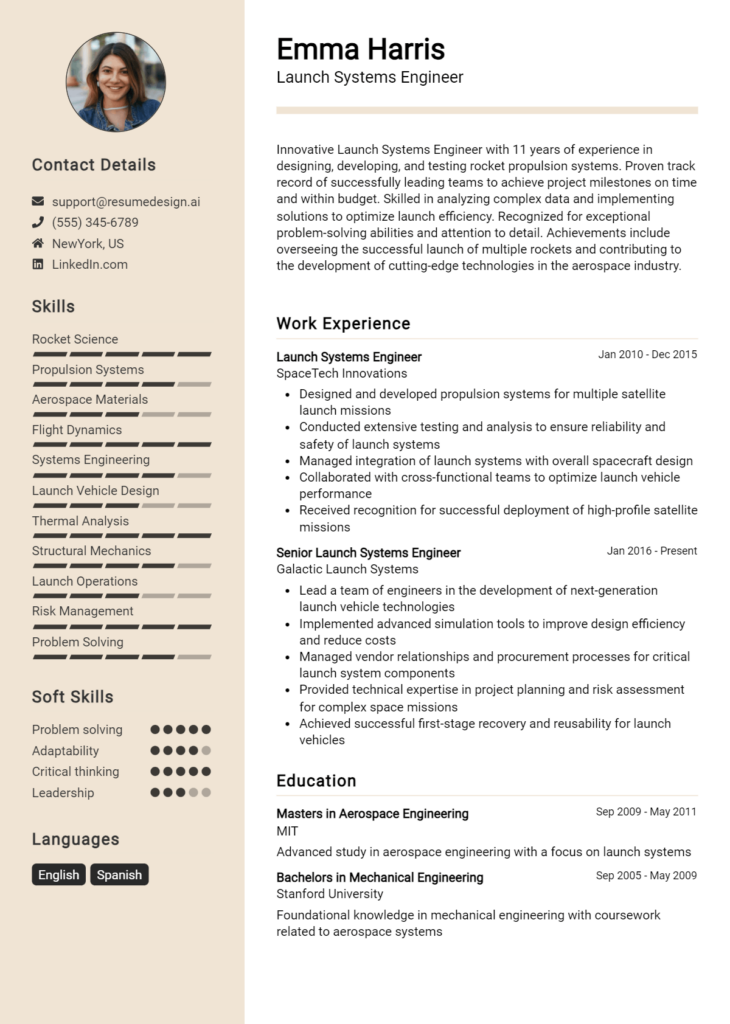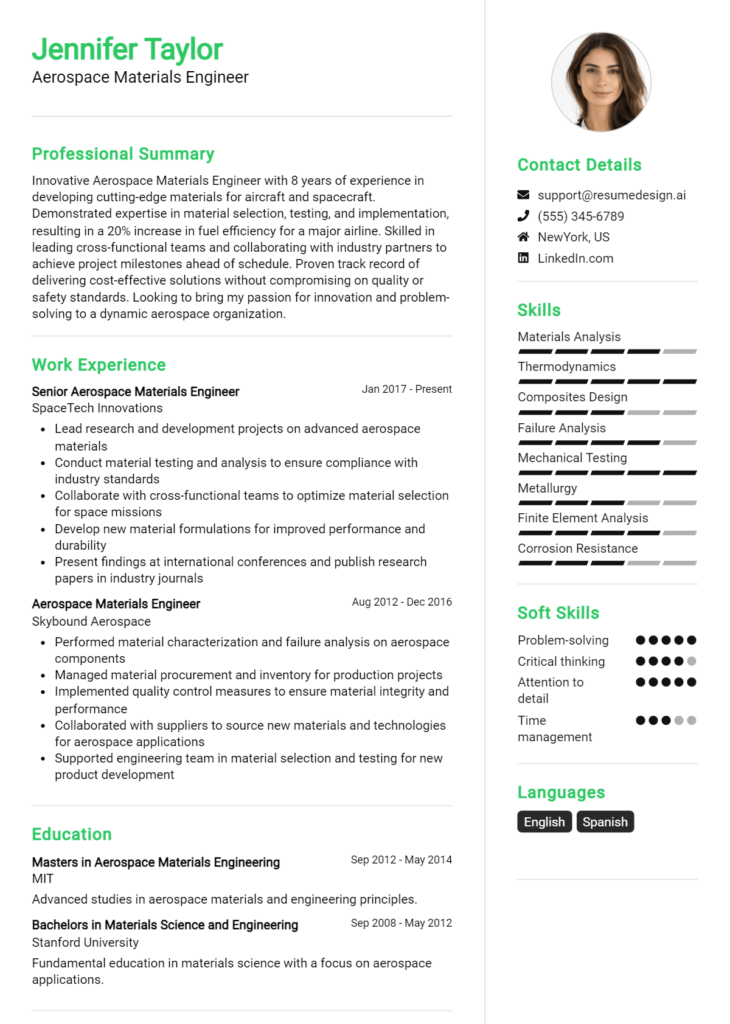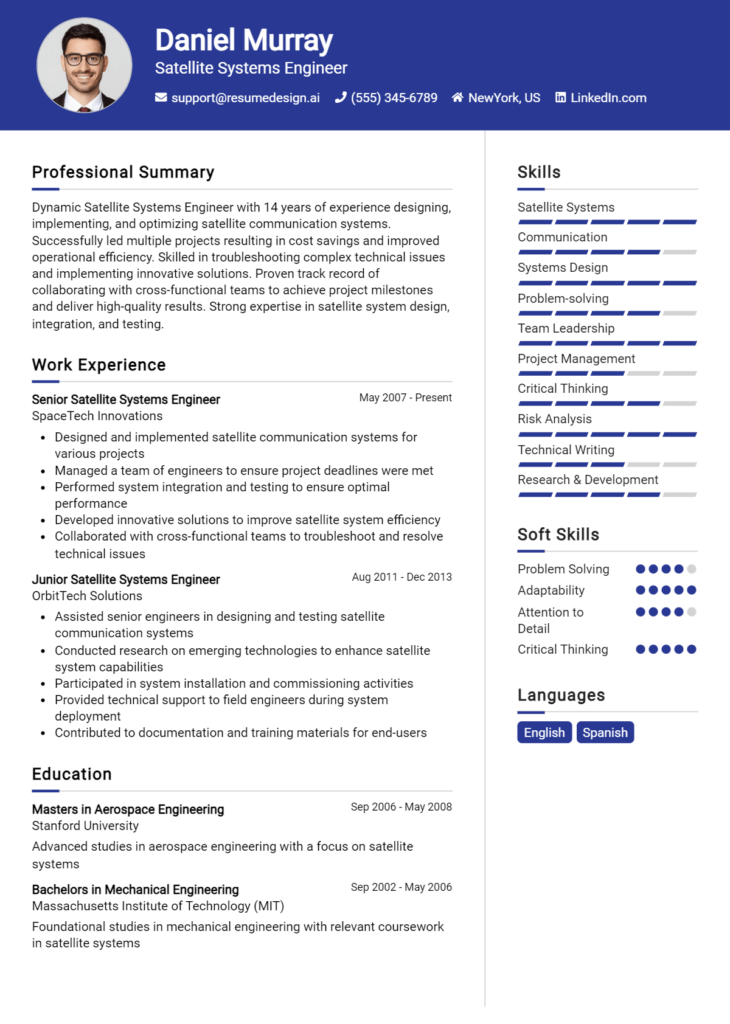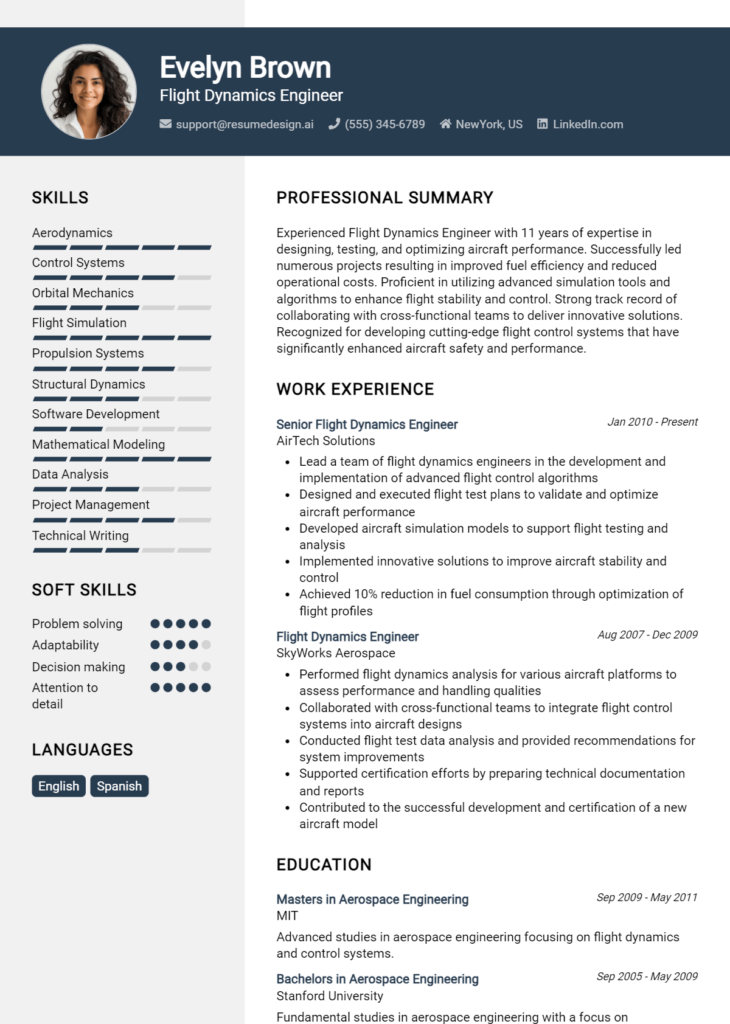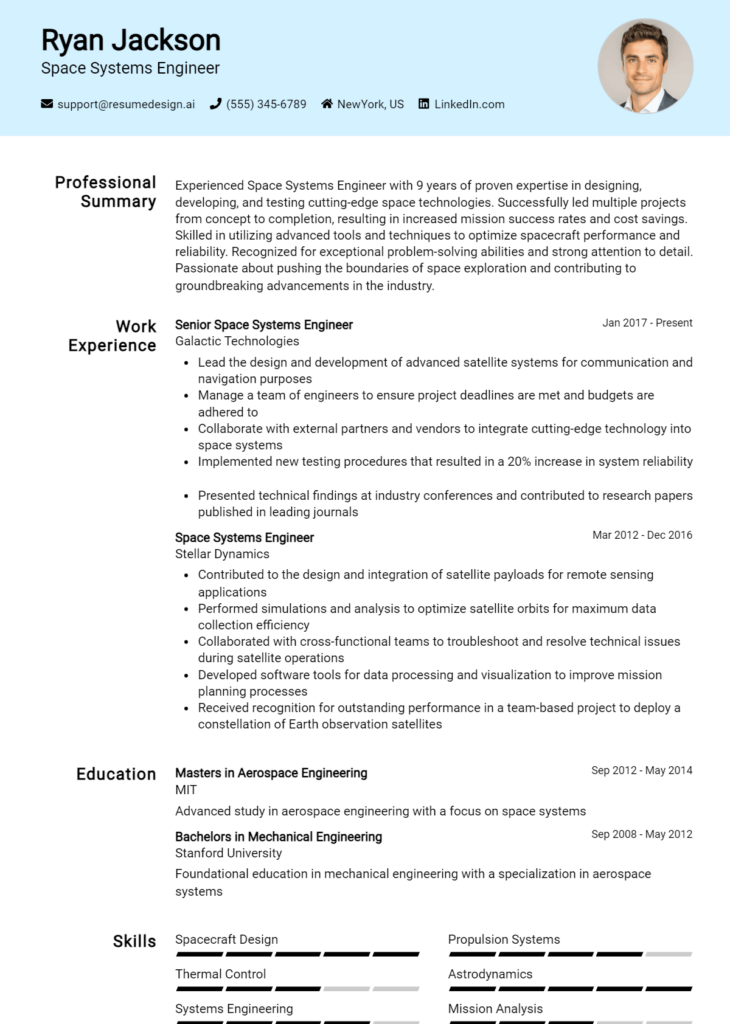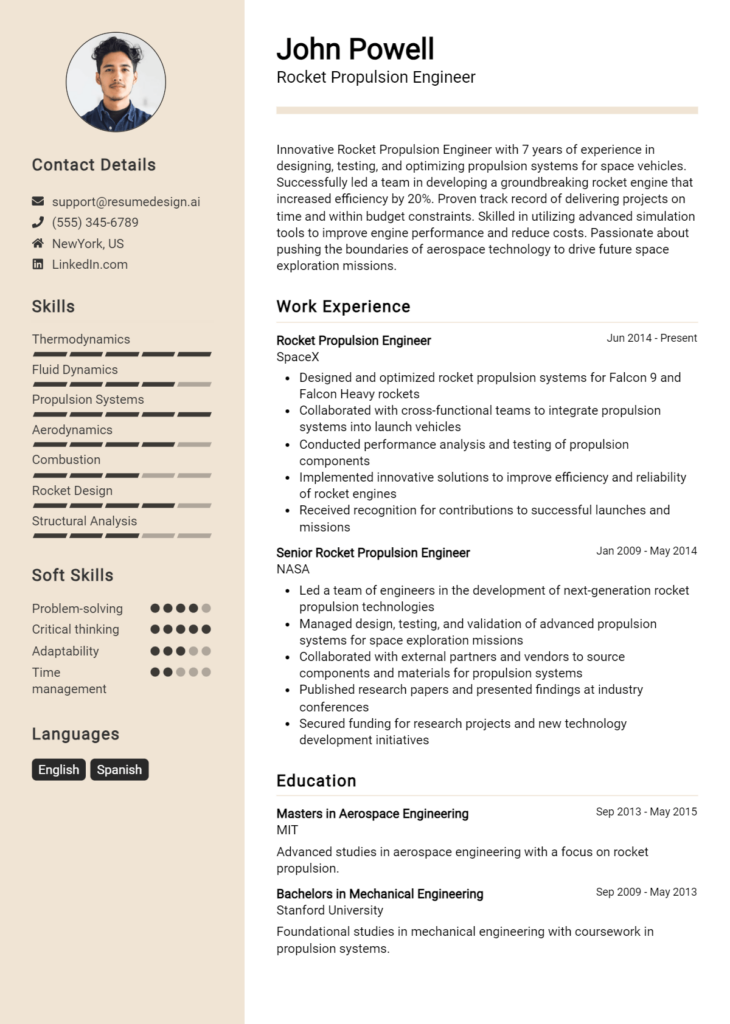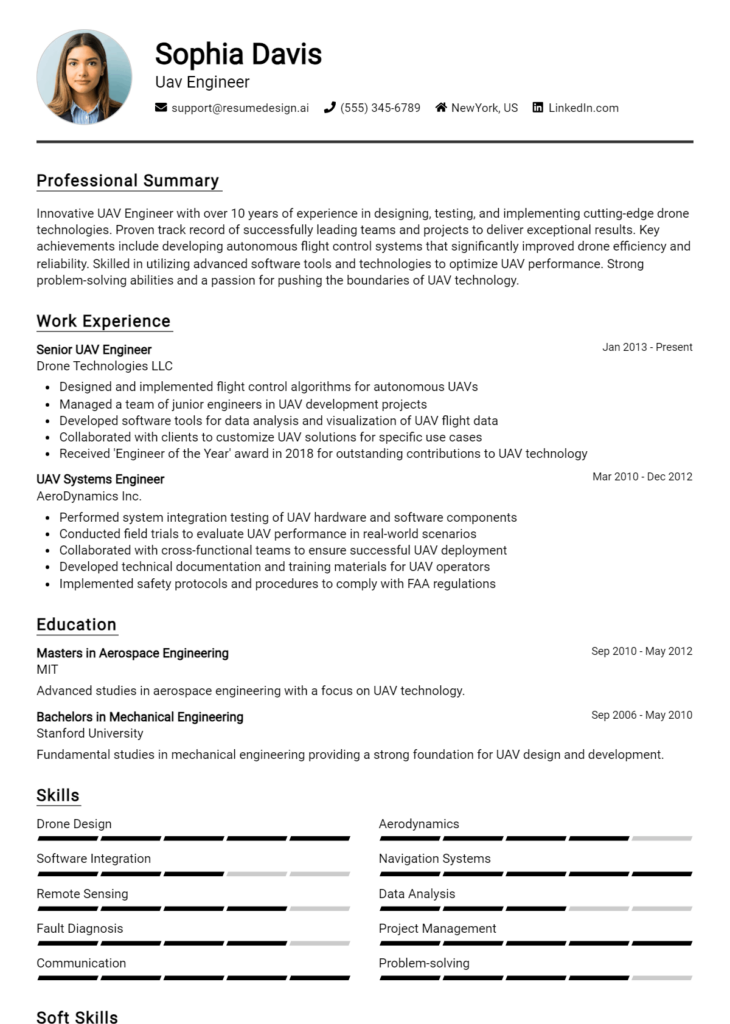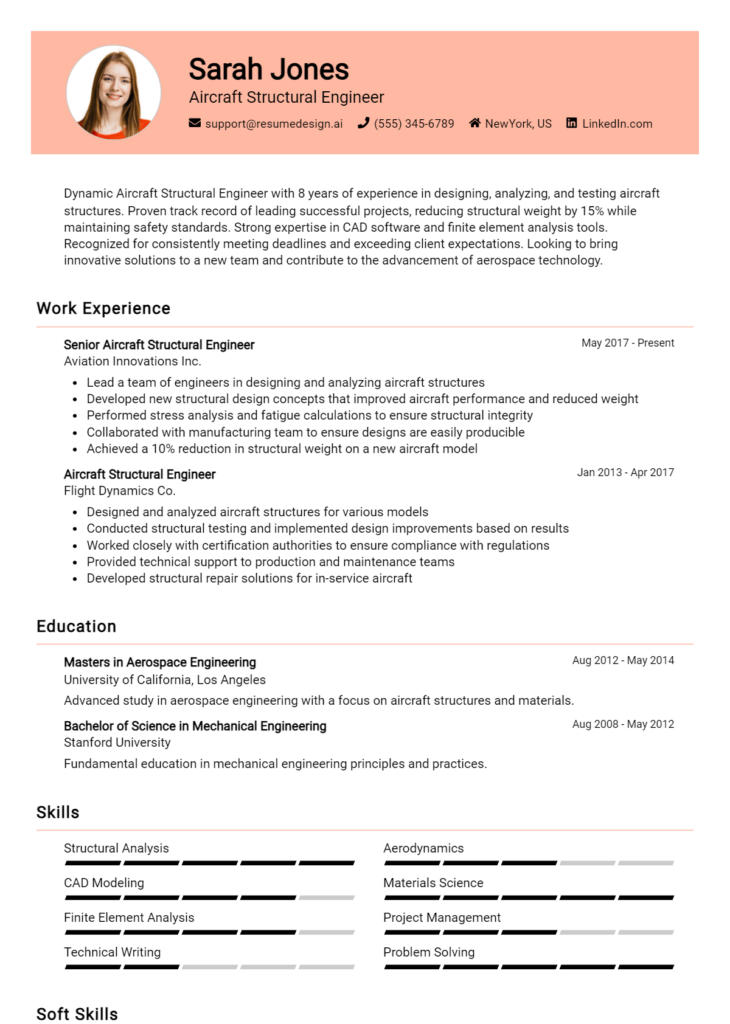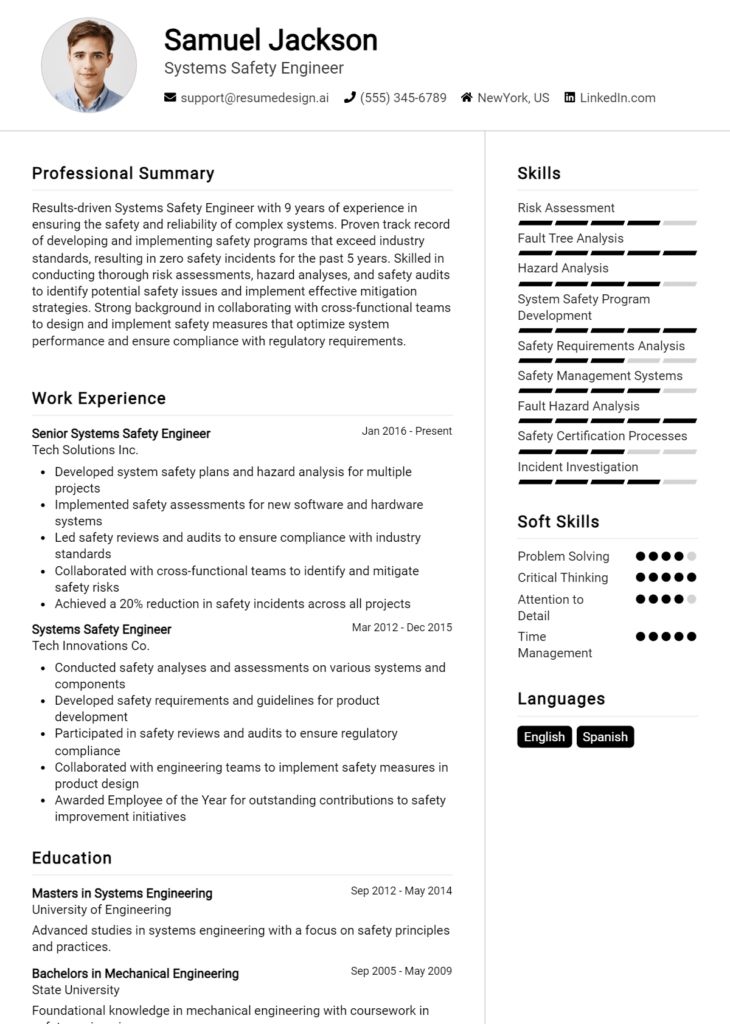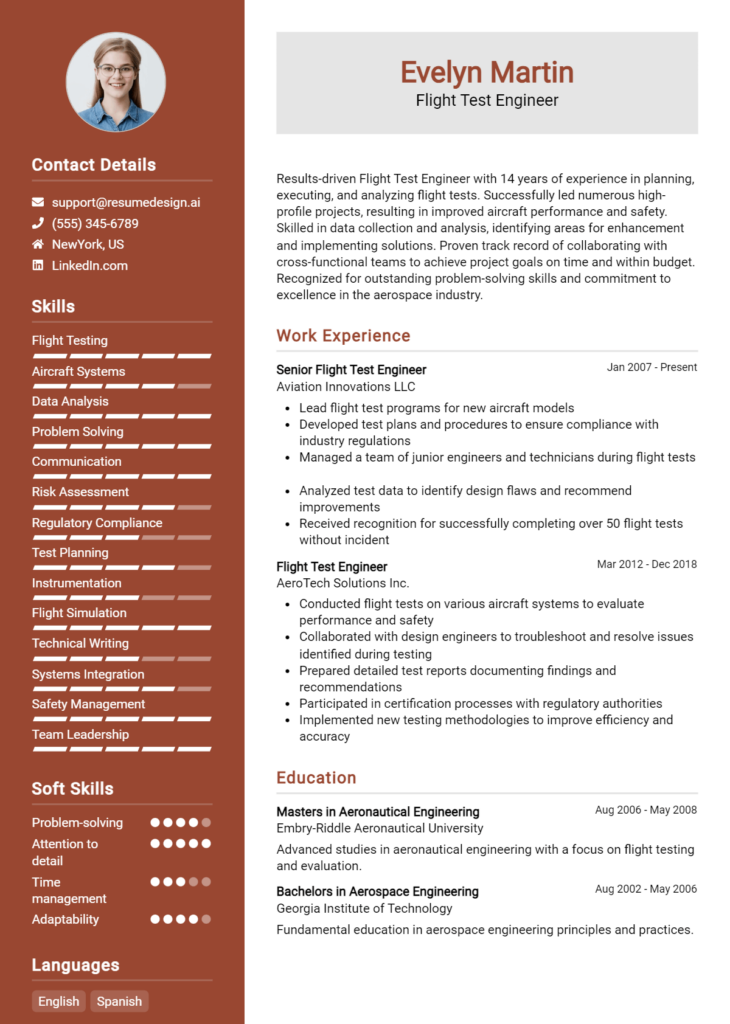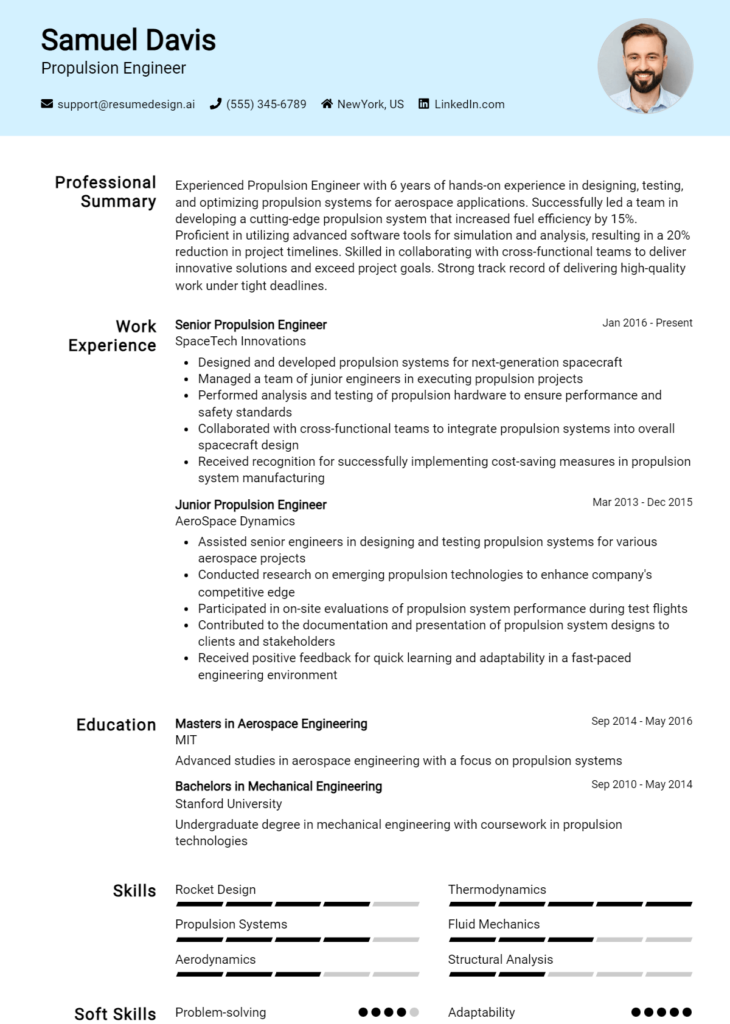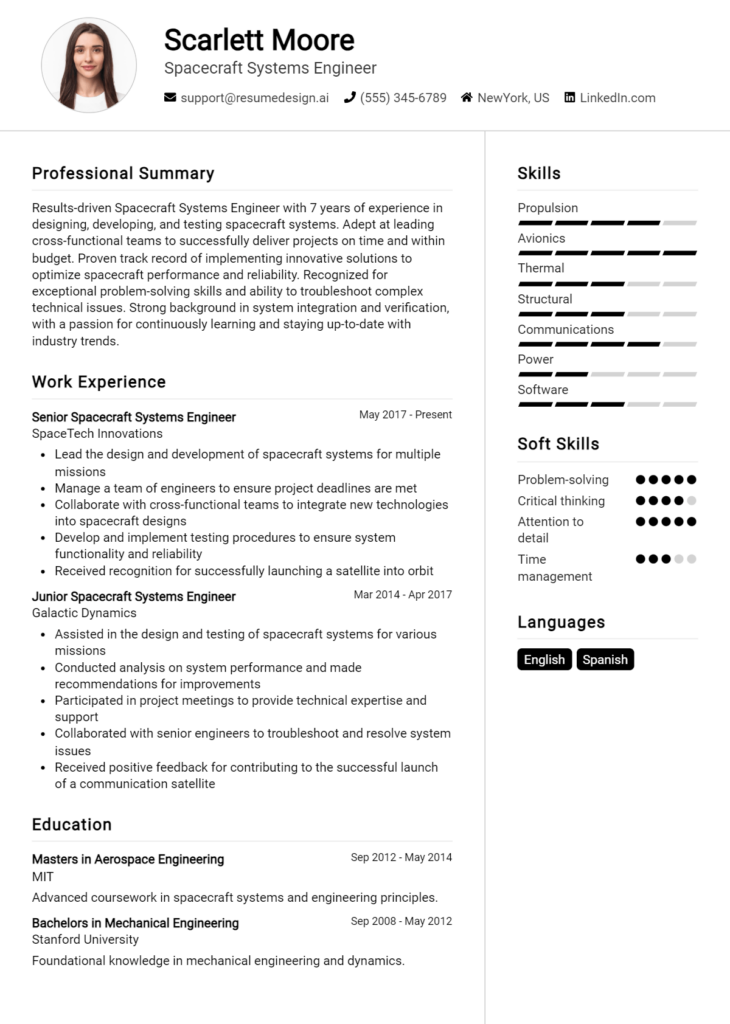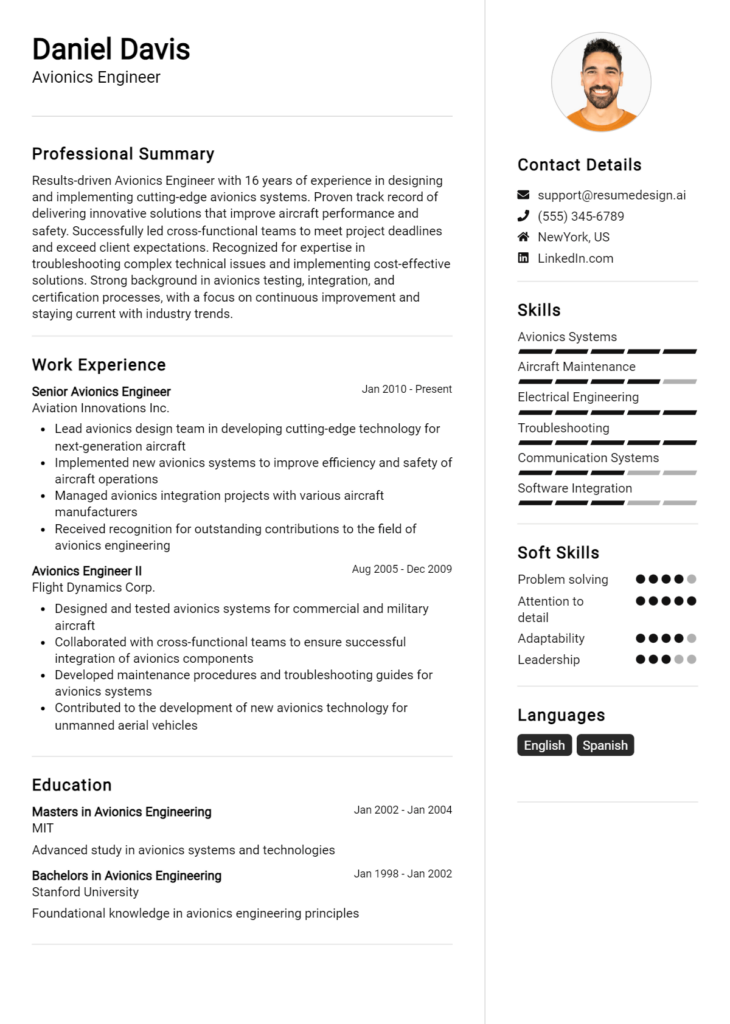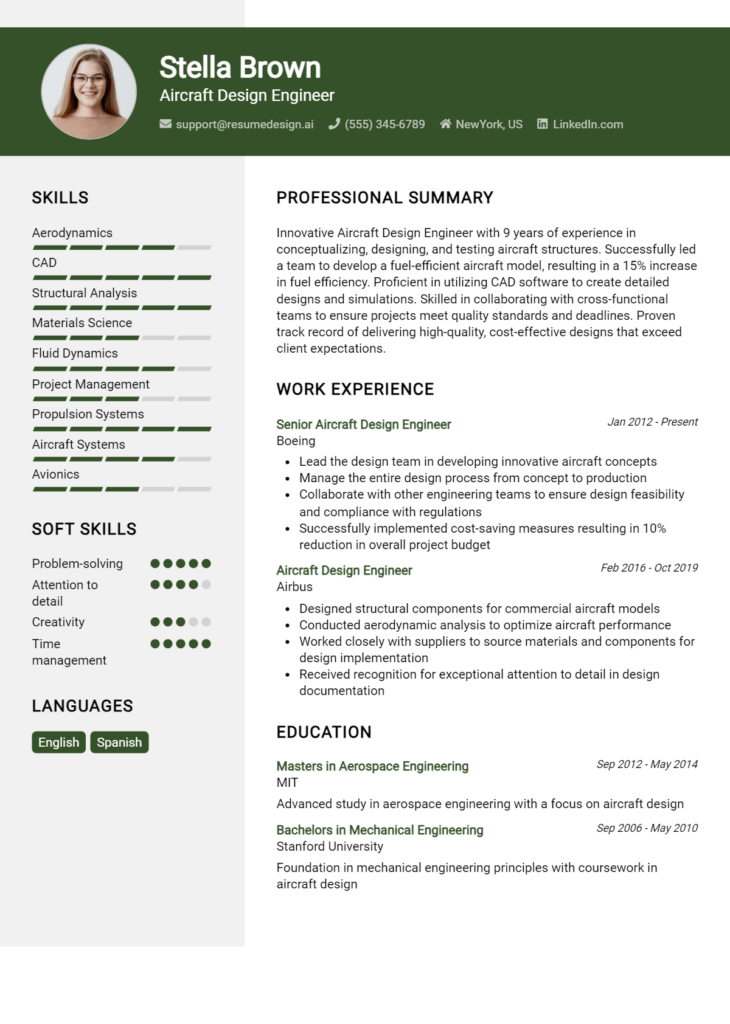Aerodynamics Engineer Core Responsibilities
Aerodynamics Engineers are pivotal in designing and optimizing vehicles, aircraft, and other systems by analyzing airflow and its effects. They collaborate across departments such as design, manufacturing, and testing, requiring strong technical knowledge in fluid dynamics, computational methods, and materials science. Problem-solving skills are essential to identify and mitigate aerodynamic issues, ensuring performance and safety. A well-crafted resume highlighting these competencies can effectively demonstrate an engineer's contribution to achieving organizational objectives.
Common Responsibilities Listed on Aerodynamics Engineer Resume
- Conduct aerodynamic analysis and simulations using computational fluid dynamics (CFD) software.
- Design and test prototypes in wind tunnel experiments to assess performance.
- Collaborate with cross-functional teams to integrate aerodynamic considerations into product development.
- Utilize mathematical models to predict airflow patterns and behavior.
- Evaluate and refine existing designs to improve efficiency and reduce drag.
- Prepare detailed technical reports and presentations for stakeholders.
- Stay updated on industry trends and advancements in aerodynamics technology.
- Perform data analysis and interpret results to inform design decisions.
- Ensure compliance with safety and regulatory standards in design processes.
- Mentor junior engineers and provide guidance on best practices.
- Participate in project planning and resource allocation for aerodynamic projects.
- Support troubleshooting and problem resolution during testing phases.
High-Level Resume Tips for Aerodynamics Engineer Professionals
In the competitive field of aerodynamics engineering, a well-crafted resume serves as a crucial tool for making a positive first impression on potential employers. Your resume not only showcases your technical skills and achievements but also reflects your dedication and professionalism. As the initial representation of your qualifications, it is essential that your resume highlights both your relevant experiences and the unique contributions you can make to a team. This guide will provide practical and actionable resume tips specifically tailored for aerodynamics engineer professionals, helping you stand out in a crowded job market.
Top Resume Tips for Aerodynamics Engineer Professionals
- Tailor your resume to match the job description, using keywords that align with the specific role.
- Highlight relevant experience in aerodynamics and related fields, focusing on projects that demonstrate your expertise.
- Quantify your achievements with metrics, such as improvements in aerodynamic efficiency or reductions in drag coefficients.
- Emphasize industry-specific skills such as computational fluid dynamics (CFD), wind tunnel testing, and software proficiency.
- Include a dedicated section for certifications and professional affiliations related to aerodynamics and engineering.
- Utilize a clean and professional format that enhances readability and showcases your technical skills effectively.
- Incorporate a summary statement that succinctly captures your professional background and key strengths.
- Showcase your teamwork and collaboration skills, as aerodynamics engineering often involves working in multidisciplinary teams.
- Include any relevant publications, presentations, or patents that can demonstrate your contributions to the field.
By implementing these tips into your resume, you can significantly increase your chances of landing a job in the aerodynamics engineering field. A polished and targeted resume not only presents your qualifications effectively but also conveys your commitment to excellence, setting the stage for a successful career in this dynamic industry.
Why Resume Headlines & Titles are Important for Aerodynamics Engineer
In the competitive field of aerodynamics engineering, a well-crafted resume headline or title can make a significant difference in capturing the attention of hiring managers. A strong headline immediately communicates the candidate's unique qualifications and expertise in a concise manner, providing a snapshot of their professional identity. It serves as the first impression and can influence a hiring manager's decision to delve deeper into the resume. Therefore, crafting a headline that is relevant to the job being applied for is crucial, as it sets the tone for the rest of the application and highlights the candidate's key strengths in just a few impactful words.
Best Practices for Crafting Resume Headlines for Aerodynamics Engineer
- Keep it concise and to the point, ideally within 10-15 words.
- Use specific keywords related to aerodynamics engineering that align with the job description.
- Highlight your most relevant skills or experiences that are applicable to the position.
- Avoid generic phrases; instead, focus on your unique strengths and contributions.
- Incorporate metrics or achievements when possible to demonstrate impact.
- Tailor the headline for each application to reflect the specific role and company.
- Use action-oriented language that conveys confidence and expertise.
- Consider including your years of experience or a specialization within aerodynamics engineering.
Example Resume Headlines for Aerodynamics Engineer
Strong Resume Headlines
Experienced Aerodynamics Engineer Specializing in High-Performance Aircraft Design
Innovative Aerodynamics Specialist with 10+ Years in Wind Tunnel Testing
Results-Driven Aerospace Engineer Focused on Fuel Efficiency Optimization
Dynamic Aerodynamics Engineer with Proven Track Record in CFD Simulations
Weak Resume Headlines
Aerodynamics Engineer Looking for Opportunities
Engineer with Experience
Professional in Engineering
The strong headlines are effective because they clearly convey the candidate's specific expertise and accomplishments, making them stand out in a crowded applicant pool. They utilize industry-relevant terminology and highlight key strengths that align with the role. In contrast, the weak headlines fail to impress because they lack specificity and do not provide any meaningful insight into the candidate's qualifications. Instead, they come off as generic and uninspired, which can easily lead to being overlooked by hiring managers searching for top talent.
Writing an Exceptional Aerodynamics Engineer Resume Summary
A well-crafted resume summary is essential for an Aerodynamics Engineer as it serves as the first impression for hiring managers. A strong summary not only captures attention but also effectively showcases key skills, relevant experience, and significant accomplishments that align with the job role. This concise and impactful section should be tailored to the specific position, allowing candidates to highlight their unique qualifications and set themselves apart in a competitive job market.
Best Practices for Writing a Aerodynamics Engineer Resume Summary
- Quantify Achievements: Use specific numbers or metrics to illustrate your successes, such as improvements in efficiency or reductions in drag.
- Focus on Skills: Highlight both technical and soft skills that are particularly relevant to aerodynamics, such as computational fluid dynamics (CFD) or teamwork.
- Tailor for the Job Description: Customize your summary to reflect the keywords and requirements outlined in the job posting.
- Be Concise: Aim for 3-5 sentences that deliver your message clearly without unnecessary fluff.
- Showcase Relevant Experience: Briefly mention past roles or projects that demonstrate your expertise in aerodynamics.
- Use Action Verbs: Start sentences with powerful action verbs to convey your contributions effectively.
- Highlight Certifications or Education: Include any relevant degrees or certifications that enhance your qualifications.
- Maintain a Professional Tone: Ensure your summary reflects professionalism and aligns with the standards of the engineering field.
Example Aerodynamics Engineer Resume Summaries
Strong Resume Summaries
Results-driven Aerodynamics Engineer with over 5 years of experience in fluid dynamics modeling and wind tunnel testing, leading to a 20% reduction in drag coefficients for multiple aircraft designs. Proficient in ANSYS and OpenFOAM, with a strong foundation in both theoretical and applied aerodynamics.
Innovative Aerodynamics Engineer skilled in optimizing aerodynamic configurations, resulting in a 15% increase in fuel efficiency for commercial jets. Expertise in computational fluid dynamics (CFD) and hands-on experience with experimental validation techniques.
Detail-oriented Aerodynamics Engineer with a Master’s degree in Aerospace Engineering and proven track record of managing cross-functional teams. Successfully delivered a project that improved lift-to-drag ratio by 10%, enhancing overall aircraft performance.
Weak Resume Summaries
Aerodynamics Engineer with some experience in the field. I have worked on various projects and am knowledgeable about aerodynamics.
Dedicated engineer looking for a role in aerodynamics. I am a team player and can adapt to different work environments.
The strong resume summaries are considered effective because they include specific metrics, relevant skills, and direct connections to the aerodynamics field, making them impactful and persuasive. In contrast, the weak summaries lack detail, fail to quantify achievements, and come across as generic, which may not capture the interest of hiring managers and could lead to missed opportunities.
Work Experience Section for Aerodynamics Engineer Resume
The work experience section of an Aerodynamics Engineer resume is crucial in demonstrating the candidate's technical skills and practical knowledge gained in the field. This section not only highlights the applicant's ability to drive projects from concept through to completion but also showcases their capacity to manage teams effectively and deliver high-quality products that meet industry standards. By quantifying achievements and aligning experiences with established benchmarks in aerodynamics, candidates can present a compelling case for their expertise and readiness for the role.
Best Practices for Aerodynamics Engineer Work Experience
- Highlight relevant technical skills, such as computational fluid dynamics (CFD) and wind tunnel testing.
- Quantify achievements with metrics, such as percentage improvements in efficiency or cost savings.
- Emphasize collaboration and teamwork, detailing experiences working with cross-functional teams.
- Tailor your experiences to align with industry standards and job requirements.
- Focus on leadership roles, showcasing instances where you led projects or mentored junior engineers.
- Describe specific technologies or tools used in projects to demonstrate technical proficiency.
- Use action-oriented language to convey your contributions and impact clearly.
- Include relevant certifications or training that reinforce your qualifications in aerodynamics.
Example Work Experiences for Aerodynamics Engineer
Strong Experiences
- Led a team of 5 engineers in the development of a new aerodynamic wing design, resulting in a 15% increase in fuel efficiency for commercial aircraft.
- Implemented advanced CFD simulations that reduced design cycle time by 30%, significantly speeding up the product development timeline.
- Collaborated with cross-disciplinary teams to optimize aerodynamic testing processes, leading to a 25% reduction in testing costs.
- Successfully managed a project that achieved a 20% improvement in lift-to-drag ratio, enhancing overall aircraft performance.
Weak Experiences
- Worked on aerodynamics projects.
- Participated in team meetings regarding design improvements.
- Assisted in testing procedures.
- Gained experience in aerodynamics.
The examples listed as strong experiences clearly demonstrate quantifiable outcomes, effective technical leadership, and meaningful collaboration, providing a strong narrative of the candidate's capabilities. In contrast, the weak experiences lack specificity and measurable results, making it difficult for potential employers to ascertain the candidate's contributions and skills in aerodynamics engineering. Strong experiences articulate clear achievements and responsibilities, whereas weak experiences fail to showcase the candidate's impact or expertise.
Education and Certifications Section for Aerodynamics Engineer Resume
The education and certifications section of an Aerodynamics Engineer resume is crucial as it serves as a testament to the candidate's academic foundation and professional expertise. This section not only highlights the educational qualifications that are essential for understanding the principles of aerodynamics but also emphasizes any industry-relevant certifications that demonstrate a commitment to continuous learning and professional development. By providing details on relevant coursework and specialized training, candidates can significantly enhance their credibility and show alignment with the specific requirements of the job role.
Best Practices for Aerodynamics Engineer Education and Certifications
- Prioritize relevant degrees in aerospace engineering, mechanical engineering, or related fields.
- Include industry-recognized certifications, such as those from the American Institute of Aeronautics and Astronautics (AIAA).
- List relevant coursework that showcases specialized knowledge in fluid dynamics, computational aerodynamics, and propulsion systems.
- Highlight any additional training in software tools commonly used in aerodynamics, like ANSYS Fluent or MATLAB.
- Use clear and concise formatting to ensure easy readability and quick reference for hiring managers.
- Tailor the education and certifications section to align with the job description, focusing on the most relevant qualifications.
- Consider including honors or awards received during educational pursuits to further demonstrate excellence.
- Update the section regularly to reflect new certifications or completed courses that relate to advancements in aerodynamics.
Example Education and Certifications for Aerodynamics Engineer
Strong Examples
- B.S. in Aerospace Engineering, University of California, Los Angeles (UCLA)
- M.S. in Mechanical Engineering with a focus on Fluid Dynamics, Massachusetts Institute of Technology (MIT)
- Certified Aerospace Technician (CAT) from the National Center for Aerospace & Transportation Technologies
- Completed coursework in Computational Fluid Dynamics and Aircraft Performance Analysis.
Weak Examples
- B.A. in History, University of Texas, Austin
- Certification in Windows IT Support, CompTIA
- Diploma in Graphic Design, Community College
- Outdated coursework in Basic Physics from 1999
The examples provided illustrate the distinction between strong and weak qualifications for an Aerodynamics Engineer role. Strong examples demonstrate a direct connection to the field through relevant degrees and certifications that highlight both educational background and specialized knowledge in aerodynamics. Conversely, weak examples indicate a lack of relevance to the profession, showcasing degrees and certifications that do not align with the skills and knowledge required for aerodynamics engineering. This contrast emphasizes the importance of tailoring educational qualifications to the specific demands of the job, enhancing the candidate's appeal to potential employers.
Top Skills & Keywords for Aerodynamics Engineer Resume
In the competitive field of aerodynamics engineering, showcasing a well-rounded set of skills on your resume is crucial for standing out to potential employers. Aerodynamics engineers are responsible for analyzing and improving the performance of various vehicles and structures through fluid dynamics, making both hard and soft skills equally important. Hard skills demonstrate your technical expertise and proficiency in specialized areas, while soft skills highlight your ability to collaborate, communicate, and adapt in a team-oriented environment. A strong resume that effectively combines these skill sets can significantly enhance your chances of landing your desired position.
Top Hard & Soft Skills for Aerodynamics Engineer
Soft Skills
- Excellent Communication
- Team Collaboration
- Problem-Solving
- Critical Thinking
- Attention to Detail
- Time Management
- Adaptability
- Creativity
- Project Management
- Analytical Mindset
Hard Skills
- Computational Fluid Dynamics (CFD)
- Aerodynamic Modeling
- Wind Tunnel Testing
- Software Proficiency (e.g., ANSYS, MATLAB)
- Structural Analysis
- Aerothermodynamics
- Numerical Methods
- Data Analysis
- Knowledge of Aerodynamic Principles
- Proficiency in CAD Software (e.g., SolidWorks, CATIA)
By emphasizing these skills and effectively detailing your work experience, you can create a compelling resume that highlights your qualifications as an aerodynamics engineer, ultimately increasing your opportunities for success in this dynamic field.
Stand Out with a Winning Aerodynamics Engineer Cover Letter
Dear [Hiring Manager's Name],
I am excited to submit my application for the Aerodynamics Engineer position at [Company Name], as advertised on [Job Board/Website]. With a Master’s degree in Aerospace Engineering and over five years of experience in aerodynamic analysis and design, I am confident in my ability to contribute effectively to your team. My background in computational fluid dynamics (CFD) and wind tunnel testing has equipped me with the skills necessary to optimize aircraft performance while ensuring safety and compliance with industry standards.
In my previous role at [Previous Company Name], I led a team that successfully redesigned the wing structure of a commercial aircraft, resulting in a 15% reduction in drag and a significant improvement in fuel efficiency. By utilizing advanced simulation tools and collaborating closely with cross-functional teams, I was able to identify key performance issues and implement innovative solutions that enhanced the overall aerodynamic efficiency of our products. My strong analytical skills and attention to detail enable me to conduct thorough analyses and deliver actionable insights that drive project success.
I am particularly impressed by [Company Name]'s commitment to sustainability and cutting-edge aerodynamics research. I am eager to bring my expertise in aerodynamic optimization and my passion for innovative engineering to your team. I believe that my proactive approach to problem-solving and my dedication to continuous learning will align perfectly with [Company Name]'s vision of pioneering advancements in aviation technology. I look forward to the opportunity to discuss how my skills and experiences can benefit your organization.
Thank you for considering my application. I hope to speak with you soon to discuss my candidacy further.
Sincerely,
[Your Name]
[Your Phone Number]
[Your Email Address]
Common Mistakes to Avoid in a Aerodynamics Engineer Resume
When crafting a resume for an Aerodynamics Engineer position, it's crucial to present your qualifications and experience effectively. However, many candidates make common mistakes that can hinder their chances of landing an interview. By avoiding these pitfalls, you can create a compelling resume that highlights your expertise in aerodynamics and captures the attention of potential employers.
Ignoring Keywords: Failing to incorporate industry-specific keywords can result in your resume being filtered out by Applicant Tracking Systems (ATS). Tailor your resume to include terms from the job description to increase visibility.
Lack of Quantifiable Achievements: Simply listing job duties can make your resume bland. Instead, showcase your accomplishments with quantifiable data, such as "increased wind tunnel efficiency by 20%."
Overly Technical Language: While technical expertise is essential, using overly complex jargon can alienate non-technical hiring managers. Aim for clarity and balance technical details with accessible language.
Not Tailoring for Each Application: Submitting a generic resume can diminish your chances. Customize your resume for each position, focusing on relevant experiences and skills that align with the specific job requirements.
Neglecting Soft Skills: While technical skills are vital, soft skills like teamwork, communication, and problem-solving are equally important in engineering roles. Highlight experiences that demonstrate these attributes.
Poor Formatting: A cluttered or unprofessional layout can distract from your qualifications. Use consistent formatting, clear headings, and bullet points to enhance readability.
Omitting Relevant Projects: If you've worked on significant projects, especially those related to aerodynamics, ensure they are included. Describe your role, the technologies used, and the outcomes achieved.
Excessive Length: A lengthy resume can overwhelm hiring managers. Aim for a concise one to two-page document, focusing on the most relevant experiences and skills that showcase your fit for the role.
Conclusion
As an Aerodynamics Engineer, your role is crucial in the design and optimization of vehicles and aircraft to ensure they perform efficiently and safely in various environments. Throughout this article, we have covered the essential skills required for this position, including fluid dynamics, computational fluid dynamics (CFD), and experience with wind tunnel testing. We also highlighted the significance of innovative thinking and collaboration with multidisciplinary teams to solve complex aerodynamic challenges.
In addition to technical expertise, the importance of a well-crafted resume cannot be overstated. Your resume should effectively showcase your qualifications, experiences, and achievements in the field of aerodynamics. To help you create an impactful resume, we encourage you to take advantage of the available resources. Explore our collection of resume templates to find a design that reflects your professional image. Utilize our resume builder to streamline the writing process and ensure all critical information is included.
Additionally, review resume examples to gain inspiration from successful Aerodynamics Engineers and see how they present their skills and experiences. Finally, don't forget to complement your resume with a compelling cover letter using our cover letter templates, which can help you articulate your passion for aerodynamics and your fit for potential employers.
Take action today to enhance your resume and stand out in this competitive field!

